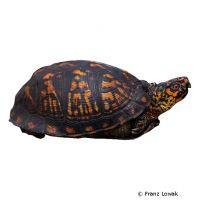Eastern Box Turtle (Terrapene carolina carolina)
| Eastern Box Turtle Terrapene carolina carolina | |
|---|---|
| Name | Eastern Box Turtle |
| Name Lat. | Terrapene carolina carolina |
| Family | Pond Turtles & Box Turtles |
| Family lat. | Emydidae |
| Order | Turtles |
| Order lat. | Testudines |
| Origin | SE-USA |
| Habitat | Shrub and grassland |
| Diet | Insects, fish, veggies |
| Humidity | 60-80 % |
| Behavior | Peaceful |
| Keeping | Individual, pair, harem |
| Care Level | Moderate |
| Reproduction | Oviparous |
| Housing | Semi-humid terrarium |
| Life Span | 25-30 years |
| Protection | CITES Appendix II; EU Annex B |
| Metric Units | |
| Size | 17 cm |
| Temperature | 25-30 °C |
| Temperature Local | 30-35 °C |
| Housing Size | 120 x 60 x 50 cm |
| US Units | |
| Size | 7" |
| Temperature | 77-86 °F |
| Temperature Local | 86-95 °F |
| Housing Size | 45" x 25" x 20" |
Distribution and habitat
Eastern box turtles are widely distributed in the eastern United States, from southern Michigan to Georgia and Florida. They inhabit a variety of habitats, including open deciduous forests, brushy grasslands, stream valleys and marshy meadows.
Maintenance
Minimum dimensions for the terrarium, according to the size and number of animals
| 1-2 animals | 5PL x 2,5PL (L x W) |
The carapace length (PL) is measured on the largest animal. For each additional animal the footprint must be increased by 10%, from the 5th animal by 20%. A terrarium of e.g. 120 x 60 x 50 cm is recommended, which should be placed in a quiet and vibration-free place.
They need a spacious terrarium, structured with epiphyte branches, stones and arched bark (hiding places), a deep, burrowable and moisture-retaining substrate, e.g. of sand-loam-peat mixture, plants and a large, shallow water basin as well as dry basking places. Part of the substrate should always be kept slightly moist. Once a day, preferably in the evening, the inside of the terrarium should be finely sprayed with water, but a misting or rain system is better.
| Temp. day: 25-30 °C | Temp. night: 18-22 °C | Temp. local: up to 35 °C | Humidity: 60-80 |
Thermostatically controlled floor heating is recommended. Lighting duration must be 10-14 hrs depending on the season. They need high light intensity and daily UV irradiation as well as sunny places with radiant heat.
Diet
In the wild they feed mainly on insects, berries, mushrooms and carrion. The food supply consists of ground beef, slugs and snails, earthworms, fish with heads and scales, and nesting rats and mice, supplemented with pelleted ready-made food for turtles and canned dog food. In addition, they absolutely need lettuce, endive, carrots, tomatoes, fruit, mushrooms and berries. They drink a lot, accordingly, must always be available sufficient drinking water. It is important to regularly add minerals and vitamins
A regular and varied diet promotes health and prevents deficiency symptoms.
Reproduction and breeding
The males have a concave ventral carapace and a thicker tail than the females. On each of its hind legs there is a toe pointing forward (copulatory claw).
Before mating, the male circles the female, bites her forelegs, and then pushes her forward. The eggs, up to 8 in number, are laid about 20 cm deep in sand-soil mixture. The incubation period is 45-65 days at a temperature of 27-31 °C.
The life expectancy can be 25-30 years.
Species protection
The animal population must be reported in writing to the competent authority immediately after the start of keeping. Subsequently, all arrivals and departures must be reported. Your pet store will be happy to provide you with further information.
Protection of species: WA Appendix II; EU Appendix B. The proof of purchase is the required proof of origin for the animal. Please keep it safe!
Important
They owe their name to a transverse joint in the abdominal armor (plastron), which allows them to fold up parts of the abdominal armor and thus, for their protection, close all armor openings.
Recommended is hibernation for 6-8 weeks in soil-moist substrate at 10-12 °C.
In order not to distort the native fauna, they must not be released into the wild under any circumstances
The terrarium must have good ventilation without drafts and meet the species-specific needs. Measuring devices such as thermometers, hygrometers, etc. are necessary. The lighting has to correspond to the species-specific day-night rhythm and has to be placed in such a way that the animals cannot injure themselves. The terrarium should be locked in such a way that neither unauthorized persons can open it nor the animals can escape. Contamination must be removed regularly.
Further literature can be found in your pet store.
References
Text: Christian Sänger; Image: Franz Lowak
Source: BMELV (1997): Tierschutzgutachten - Mindestanforderungen an die Haltung von Reptilien; ENGELMANN (2006): Zootierhaltung - Tiere in menschlicher Obhut: Reptilien und Amphibien, Harri Deutsch Verlag; ROGNER (2009): Taschenatlas Schildkröten, Verlag Ulmer
- Gemäß § 21 Abs. 5 Tierschutzgesetz idgF
